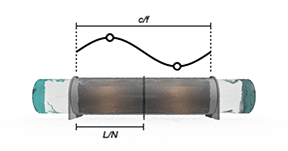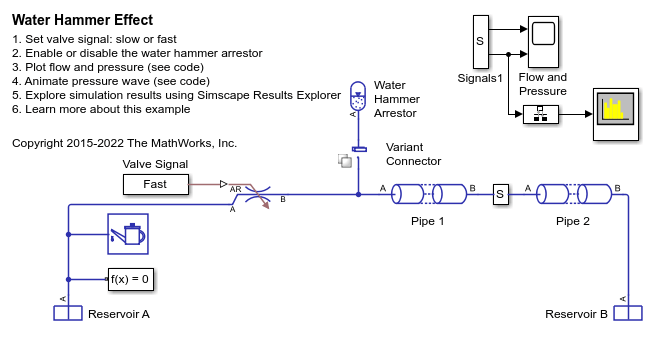Pipe (IL)
Pipe segment in an isothermal liquid network
Libraries:
Simscape /
Fluids /
Isothermal Liquid /
Pipes & Fittings
Description
The Pipe (IL) block models flow in a rigid or flexible-walled pipe with losses due to wall friction. The effects of dynamic compressibility, fluid inertia, and pipe elevation can be optionally modeled. You can define multiple pipe segments and set the liquid pressure for each segment. By segmenting the pipe and selecting Enable fluid inertia, you can model events such as water hammer in your system.
Pipe Characteristics
The pipe block can be divided into segments with the Number of segments parameter. When the pipe is composed of a number of segments, the pressure in each segment is calculated based on the inlet pressure and the effect on the segment mass flow rate of the fluid compressibility and wall flexibility, if applicable. The fluid volume in each segment remains fixed. For a two-segment pipe, the pressure evolves linearly with respect to the pressure defined at ports A and B. For a pipe with three or more segments, you can specify the fluid pressure in each segment in vector or scalar form in the Initial liquid pressure parameter. The scalar form will apply a constant value over all segments.
You can model flexible walls for all cross-sectional geometries. When you set
Pipe wall specification to
Flexible, the block assumes uniform expansion
along all directions and preserves the defined cross-sectional shape. This
setting may not result in physical results for noncircular cross-sectional areas
undergoing high pressure relative to atmospheric pressure. When you model
flexible walls, you can use the Volumetric expansion
specification parameter to control the method for specifying the
volumetric expansion of the pipe cross-sectional area.
When the Volumetric expansion specification parameter is
Cross-sectional area vs. pressure, the change in
volume is modeled by
where:
L is the Pipe length parameter.
SN is the nominal pipe cross-sectional area defined for each shape.
S is the current pipe cross-sectional area.
p is the internal pipe pressure.
patm is the atmospheric pressure.
Kps is the Static gauge pressure to cross-sectional area gain parameter.
To calculate Kps assuming uniform elastic deformation of a thin-walled, open-ended cylindrical pipe, use:
where t is the pipe wall thickness and E is Young's modulus.
τ is the Volumetric expansion time constant.
When the Volumetric expansion specification parameter is
Cross-sectional area vs. pressure - Tabulated,
the block uses the same equation for as the Cross-sectional area vs.
pressure setting. The block calculates A
with the table lookup function
where pps is the Static gauge pressure vector parameter and Aps is the Cross sectional area gain vector parameter.
When the Volumetric expansion specification parameter is
Hydraulic diameter vs. pressure, the change in
volume is modeled by
where:
DN is the nominal hydraulic diameter defined for each shape.
D is the current pipe hydraulic diameter.
Kpd is the Static gauge pressure to hydraulic diameter gain parameter. To calculate Kps assuming uniform elastic deformation of a thin-walled, open-ended cylindrical pipe, use:
When the Volumetric expansion specification parameter is
Based on material properties, the block uses the
same equation for as the Hydraulic diameter vs.
pressure setting but calculates
Dstatic depending on the value
of the Material behavior parameter
This parameterization assumes a cylindrical thin-walled pressure vessel where
When the Material behavior parameter is Linear
elastic,
where:
E is the value of the Young's modulus parameter.
v is the value of the Poisson's ratio parameter.
where t is the value of the Pipe wall thickness parameter.
When the Material behavior parameter is Multilinear
elastic, the block calculates the von Mises stress,
σv, which simplifies to , to determine the equivalent strain. The hoop strain is
where:
The block calculates the Young's Modulus, E, from the first elements of the Stress vector and Strain vector parameters.
, where σtotal and εtotal are the equivalent total stress and the equivalent total strain, respectively. The block calculates the equivalent total strain from the von Mises stress and the stress-strain curve.
where σi,j are the elements of the Cauchy stress tensor.
If you do not model flexible walls, SN = S and DN = D.
The nominal hydraulic diameter and the Pipe diameter, dcircle, are the same. The pipe cross sectional area is:
The nominal hydraulic diameter, Dh,nom, is the difference between the Pipe outer diameter and Pipe inner diameter, do – di. The pipe cross sectional area is
The nominal hydraulic diameter is:
where:
h is the Pipe height.
w is the Pipe width.
The pipe cross sectional area is
The nominal hydraulic diameter is:
where:
amaj is the Pipe major axis.
bmin is the Pipe minor axis.
The pipe cross sectional area is
The nominal hydraulic diameter is:
where:
lside is the Pipe side length.
θ is the Pipe vertex angle.
The pipe cross sectional area is
Pressure Loss Due to Friction
The analytical Haaland correlation models losses due to wall friction either by aggregate equivalent length, which accounts for resistances due to nonuniformities as an added straight-pipe length that results in equivalent losses, or by local loss coefficient, which directly applies a loss coefficient for pipe nonuniformities.
When the Local resistances specification parameter is set
to Aggregate equivalent length and the flow in the
pipe is lower than the Laminar flow upper Reynolds number
limit, the pressure loss over all pipe segments is:
where:
ν is the fluid kinematic viscosity.
λ is the Laminar friction constant for Darcy friction factor, which you can define when Cross-sectional geometry is set to
Customand is otherwise equal to 64.D is the pipe hydraulic diameter.
Ladd is the Aggregate equivalent length of local resistances.
A is the mass flow rate at port A.
B is the mass flow rate at port B.
When the Reynolds number is greater than the Turbulent flow lower Reynolds number limit, the pressure loss in the pipe is:
where:
f is the Darcy friction factor. This is approximated by the empirical Haaland equation and is based on the Surface roughness specification, ε, and pipe hydraulic diameter:
Pipe roughness for brass, lead, copper, plastic, steel, wrought iron, and galvanized steel or iron are provided as ASHRAE standard values. You can also supply your own Internal surface absolute roughness with the
Customsetting.ρI is the internal fluid density.
When the Local resistances specification parameter is set
to Local loss coefficient and the flow in the pipe is
lower than the Laminar flow upper Reynolds number limit,
the pressure loss over all pipe segments is:
When the Reynolds number is greater than the Turbulent flow lower Reynolds number limit, the pressure loss in the pipe is:
where Closs,total is the loss coefficient, which can be defined in the Total local loss coefficient parameter as either a single coefficient or the sum of all loss coefficients along the pipe.
The Nominal Pressure Drop vs. Nominal Mass Flow Rate parameterization characterizes losses with a loss coefficient for rigid or flexible walls. When the fluid is incompressible, the pressure loss over the entire pipe due to wall friction is:
where Kp is:
where:
ΔpN is the Nominal pressure drop, which can be defined either as a scalar or a vector.
is the Nominal mass flow rate, which can be defined either as a scalar or a vector.
When the Nominal pressure drop and Nominal mass flow rate parameters are supplied as vectors, the scalar value Kp is determined from a least-squares fit of the vector elements.
Pressure losses due to viscous friction can also be determined from user-provided tabulated data of the Darcy friction factor vector and the Reynolds number vector for turbulent Darcy friction factor parameters. Linear interpolation is employed between data points.
Pipe Discretization
You can divide the pipe into multiple segments. If a pipe has more than one segment, the mass flow and momentum balance equations are calculated for each segment.
If you would like to capture specific phenomena in your application, such as water hammer, choose a number of segments that provides sufficient resolution of the transient. The following formula, from the Nyquist sampling theorem, provides a rule of thumb for pipe discretization into a minimum of N segments:

where:
L is the Pipe length.
f is the transient frequency.
c is the speed of sound.
Mass and Momentum Balance
When you clear the Enable dynamic compressibility checkbox, the mass flow into the pipe equals the mass flow out of the pipe
When you select Enable dynamic
compressibility and set Pipe wall specification
to Rigid, the difference between the mass flow into and
out of the pipe depends on the fluid density change due to compressibility,
When you select Enable dynamic
compressibility and set Pipe wall specification
to Flexible, the difference between the mass flow into
and out of the pipe is based on the change in fluid density due to compressibility,
and the amount of fluid accumulated in the newly deformed regions of the pipe:
The changes in momentum between the pipe inlet and outlet comprises the changes in pressure due to pipe wall friction, which is modeled according to the Viscous friction parameterization and pipe elevation.
When you clear the Enable fluid inertia checkbox, the momentum balance is:
where:
pA is the pressure at port A.
pI is the fluid volume internal pressure.
pB is the pressure at port B.
Δpf is the pressure loss due to wall friction, parameterized by the Viscous friction losses specification according to the respective port.
Δz is the pipe elevation. In the case of constant-elevation pipes, this is the Elevation gain from port A to port B parameter; otherwise, it is received as a physical signal at port EL.
g is the gravitational acceleration. In the case of a fixed gravitational constant, this is the Gravitational acceleration parameter; otherwise, it is received as a physical signal at port G.
When you select Enable fluid inertia, the momentum balance is:
where:
is the fluid acceleration at its respective port.
S is the pipe cross-sectional area.
Examples
Ports
Conserving
Inputs
Parameters
References
[1] Budynas R. G. Nisbett J. K. & Shigley J. E. (2004). Shigley's mechanical engineering design (7th ed.). McGraw-Hill.
[2] Ju Frederick D., Butler Thomas A., Review of Proposed Failure Criteria for Ductile Materials (1984) Los Alamos National Laboratory.
[3] Hencky H (1924) Zur Theorie plastischer Deformationen und der hierdurch im Material hervorgerufenen Nachspannungen. Z Angew Math Mech 4:323–335
[4] Jahed H, “A Variable Material Property Approach for Elastic-Plastic Analysis of Proportional and Non-proportional Loading, (1997) University of Waterloo
Extended Capabilities
Version History
Introduced in R2020aSee Also
Partially Filled Pipe (IL) | Pipe (TL) | Pipe (IL) | Elbow (IL) | T-Junction (IL) | Tank (IL)


